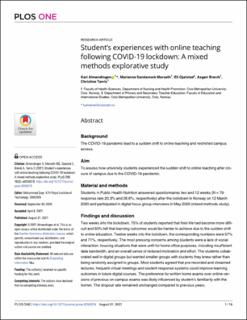| dc.contributor.author | Almendingen, Kari | |
| dc.contributor.author | Morseth, Marianne S. | |
| dc.contributor.author | Gjølstad, Eli | |
| dc.contributor.author | Brevik, Asgeir | |
| dc.contributor.author | Tørris, Christine | |
| dc.date.accessioned | 2022-02-25T08:07:45Z | |
| dc.date.available | 2022-02-25T08:07:45Z | |
| dc.date.created | 2021-10-05T10:50:46Z | |
| dc.date.issued | 2021 | |
| dc.identifier.citation | PLOS ONE. 2021, 16 (8), e0250378 | en_US |
| dc.identifier.issn | 1932-6203 | |
| dc.identifier.uri | https://hdl.handle.net/11250/2981358 | |
| dc.description.abstract | Background The COVID-19 pandemic lead to a sudden shift to online teaching and restricted campus access. Aim To assess how university students experienced the sudden shift to online teaching after closure of campus due to the COVID-19 pandemic. Material and methods Students in Public Health Nutrition answered questionnaires two and 12 weeks (N = 79: response rate 20.3% and 26.6%, respectively) after the lockdown in Norway on 12 March 2020 and participated in digital focus group interviews in May 2020 (mixed methods study). Findings and discussion Two weeks into the lockdown, 75% of students reported that their life had become more difficult and 50% felt that learning outcomes would be harder to achieve due to the sudden shift to online education. Twelve weeks into the lockdown, the corresponding numbers were 57% and 71%, respectively. The most pressing concerns among students were a lack of social interaction, housing situations that were unfit for home office purposes, including insufficient data bandwidth, and an overall sense of reduced motivation and effort. The students collaborated well in digital groups but wanted smaller groups with students they knew rather than being randomly assigned to groups. Most students agreed that pre-recorded and streamed lectures, frequent virtual meetings and student response systems could improve learning outcomes in future digital courses. The preference for written home exams over online versions of previous on-campus exams was likely influenced by student’s familiarity with the former. The dropout rate remained unchanged compared to previous years.
Conclusion The sudden shift to digital teaching was challenging for students, but it appears that they adapted quickly to the new situation. Although the concerns described by students in this study may only be representative for the period right after campus lockdown, the study provide the student perspective on a unique period of time in higher education. | en_US |
| dc.language.iso | eng | en_US |
| dc.rights | Navngivelse-DelPåSammeVilkår 4.0 Internasjonal | * |
| dc.rights.uri | http://creativecommons.org/licenses/by-sa/4.0/deed.no | * |
| dc.subject | COVID 19 | en_US |
| dc.subject | Education | en_US |
| dc.subject | Pandemics | en_US |
| dc.subject | Students | en_US |
| dc.subject | Teachers | en_US |
| dc.subject | Online teaching | en_US |
| dc.title | Student's experiences with online teaching following COVID-19 lockdown: A mixed methods explorative study | en_US |
| dc.type | Peer reviewed | en_US |
| dc.type | Journal article | en_US |
| dc.description.version | publishedVersion | en_US |
| dc.source.articlenumber | e0250378 | en_US |
| cristin.ispublished | true | |
| cristin.fulltext | original | |
| cristin.qualitycode | 1 | |
| dc.identifier.doi | 10.1371/journal.pone.0250378 | |
| dc.identifier.cristin | 1943318 | |
| dc.source.journal | PLOS ONE | en_US |
| dc.source.volume | 16 | en_US |
| dc.source.issue | 8 | en_US |

